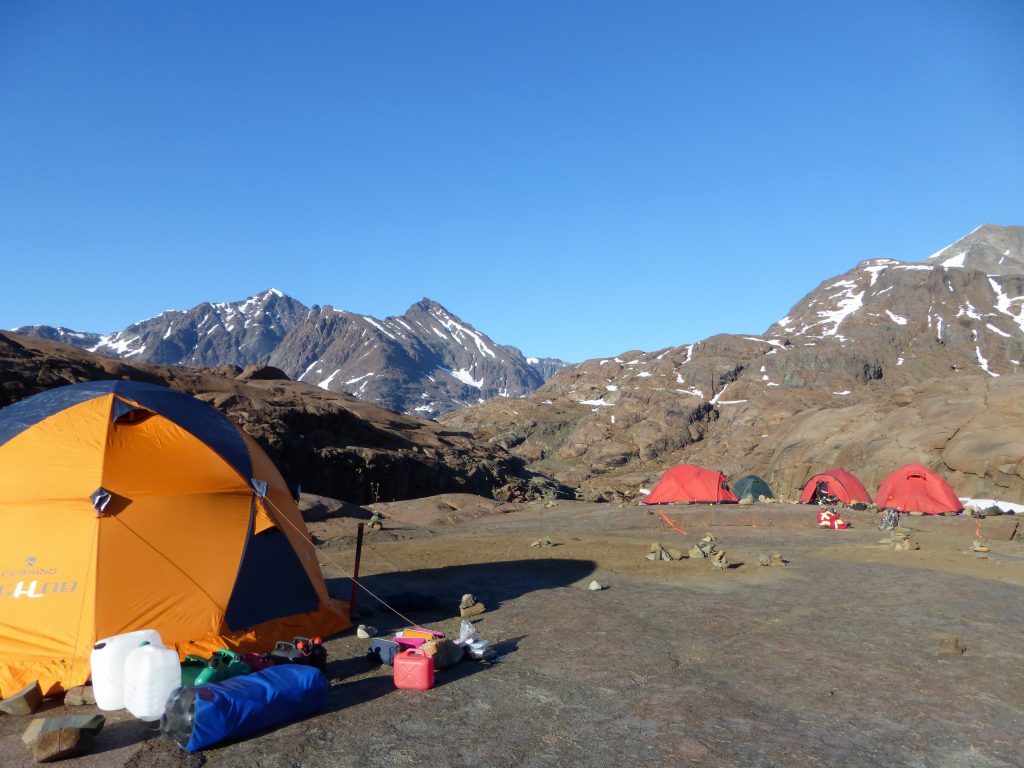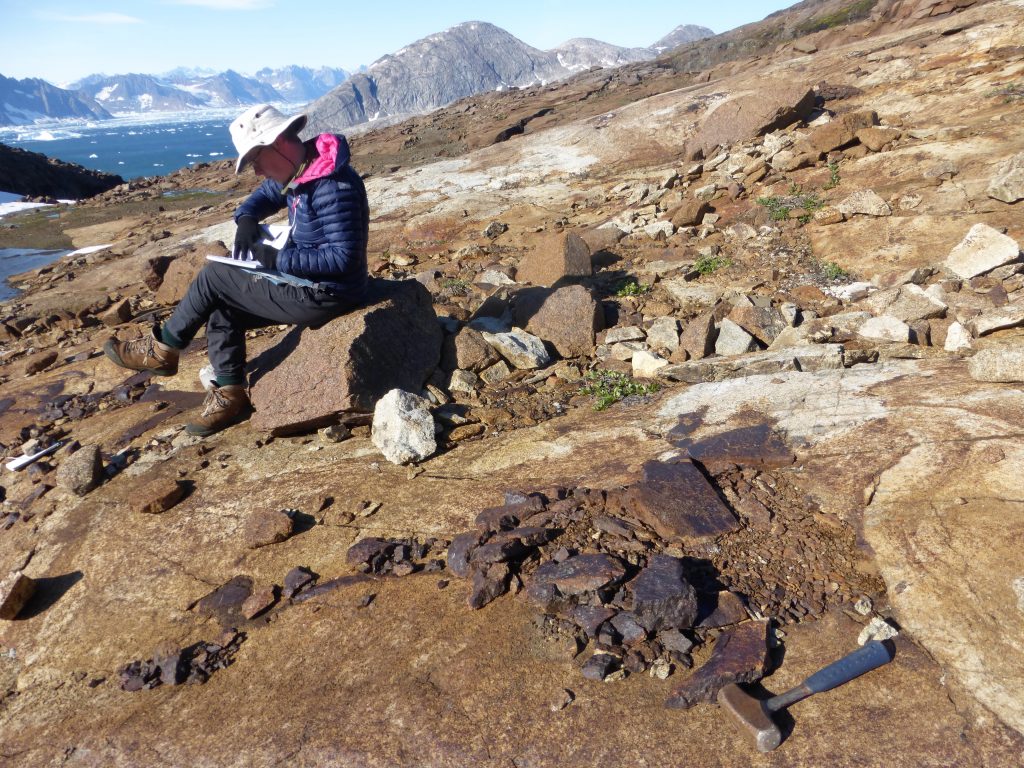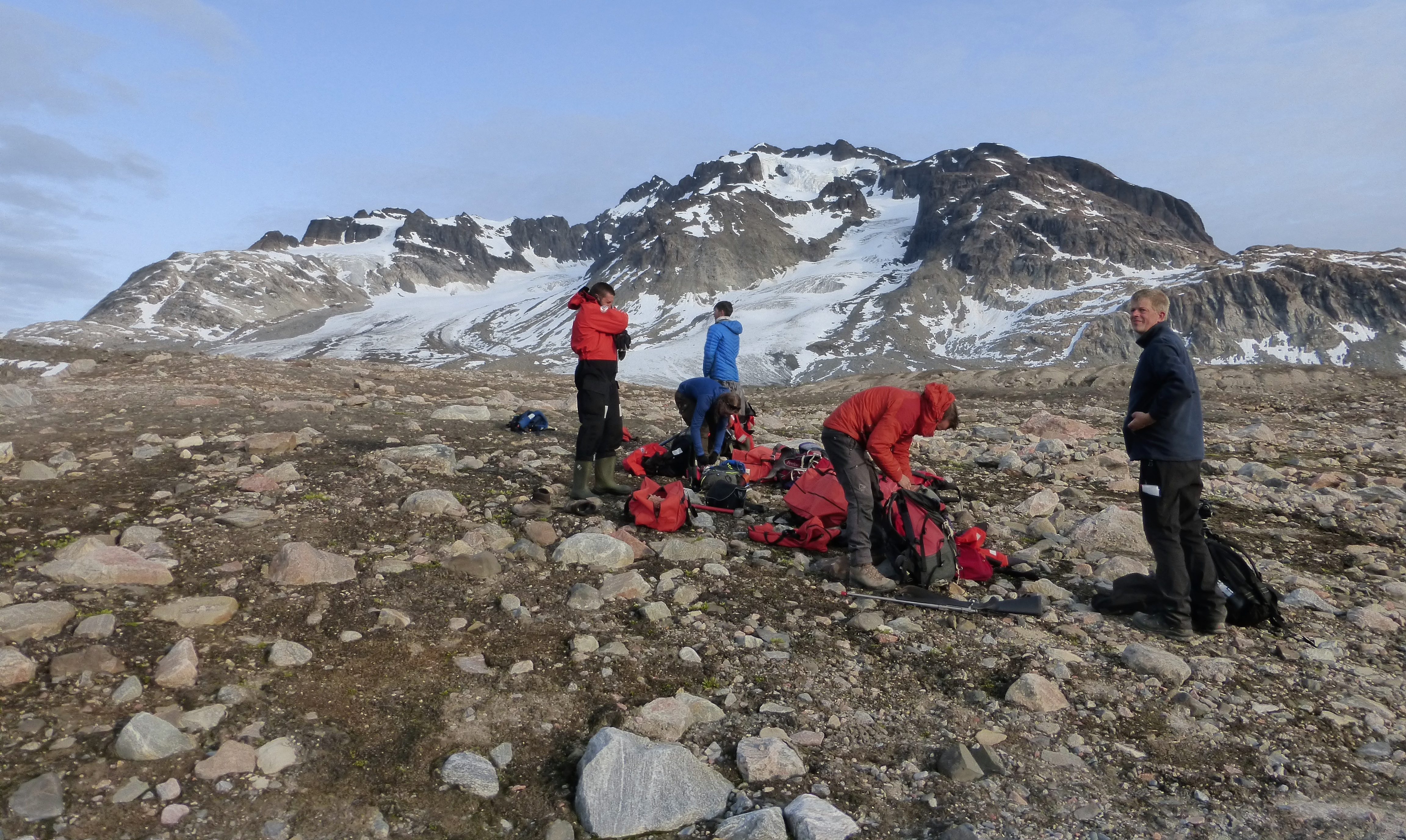Skaergaard is a classic example of a layered intrusion. It is a wonderful natural laboratory for geologists and highly photogenic, with its striking igneous layering. There is near 100% surface exposure as not much grows there; an advantage of its location at 68°N. We have just returned from a six week expedition, studying this fascinating intrusion.
The team comprised six geologists: four of us from Cambridge; one from the Danish Geological Survey and one from Camborne School of Mines at the University of Exeter. Our summer was spent camping on the rocks and exploring the intrusion… an amazing place to do geology!
The Cambridge Department of Earth Sciences has a long history of expeditions to this iconic geological locality. Lawrence Wager, a Cambridge undergraduate at Pembroke College (m. 1926), was part of a British Arctic Air Route Expedition that discovered Skaergaard in 1930 whilst hunting for a transatlantic air route across Greenland. He subsequently overwintered on the intrusion from July 1935 to August 1936 with a team that included his newly wed wife. Wager was a petrologist who concentrated on discerning processes within igneous systems, and many of his ideas form the foundations of modern day igneous petrology. As such a well-studied intrusion, some cynics asked if there was anything left to do on Skaergaard… we can safely reassure them that yes, there are plenty of new and exciting discoveries to be made!
We left Cambridge in the rain for our delayed flight from Heathrow to Iceland, and then on to Kulusuk Island – after an hour of circling and approaching the airstrip in heavy fog we finally arrived in remote East Greenland. We walked down to a small harbour where our boat for the journey north was moored, surrounded by the local hunters’ seal carcasses. The town’s dogs were howling as we assembled our flat-packed zodiac boat (a good team bonding exercise!) and tried on our fluorescent orange goretex survival suits.

Our three day sail north was a serene start to the fieldwork and a chance for Arctic acclimatisation. It gave us all the time to disconnect from the manic weeks leading up to such a big expedition and to concentrate on the plan for the next month and a half on Skaergaard. We sailed past a WW2 American coastal airstrip, complete with hundreds of disintegrating, rusty oil drums and a sunbathing humpback whale. For hours on end, we slowly navigated our way through large areas of densely packed icebergs forming a rather spectacular icey jigsaw puzzle. We stopped off at an iceberg to replenish our dwindling fresh water supplies enroute (it had a slight hint of seasalt) and finally reached Skaergaard (and fresh water!) incident free, as the sun was setting.

We went out to Skaergaard with a range of work priorities and a mixed-bag of experience. The team had a great range of geological expertise: igneous, metamorphic, economic petrology, from large scale structures down to the minutest microstructure. Having so long in the field was extremely conducive to group reflection and discussion. It meant hypotheses developed at the outcrop could be tested, altered and refined in the evenings. It also gave us the opportunity to cover a large ground area in a lot of detail, noticing features that had been previously overlooked. The number and breadth of science projects that came out of this trip is fantastic and will keep us all busy for a few years! We collected a whole range of datasets, from focused measurements of small-scale features to intrusion-wide sampling. These will be used for numerous scientific projects, from exploring for a Ti-V resource, to finding evidence of what was below the Skaergaard magma, from investigating sedimentary structures in a magma chamber, to looking at how permeable the mush was and how far interstitial liquids could travel.

The first couple of days saw us settle into our daily routine, balancing camp life with science research. We were too late in the season for midnight sun, but in August we had about 19 hours of daylight. Sadly we didn’t see the northern lights until our return to Kulusuk Island. It was a fantastic field season, with only three weather days during which we couldn’t leave camp. Our daily commute in the field was an exhilarating boat ride wearing the lurid orange survival suits, followed by a hike to whatever locality we were interested in that day. In the field we used a wide range of kit: we had the geology staples of chalk, chisels and, of course, a trusty hammer. But we also had a rock drill so we could take small (~2 cm diameter) cores of rock and a drone to take aerial photos and videos.

We didn’t look at rocks all the time, we also had a foray into ice… we found a beautifully clear piece of ice where you could see the individual crystals. Where three ice crystals met ‘triple junctions’ were formed. The piece of ice was artfully balanced on top of a whale vertebra (found in our camp), and we poured soy sauce through it so that we could see the network of connected junctions… Worked a treat!
September marked the end of summer and we all began to notice the changing season. The few plants turned a beautiful array of autumnal colours and one day we woke up to find the fjord covered with a thin sheet of ice. Another day the majestic view of Wager’s Peak was shrouded in snow and a smattering reached our tents. The landscape has a harsh beauty to it in summer, but our brief taste of bad weather hinted at the transformation the region undergoes as winter arrives. We saw a plethora of wildlife: plenty of seals, a polar bear swimming in the fjord, arctic foxes and a ptarmigan. Strangely, ravens are the only birdlife that we really came across in our time out there. Despite being so far removed from civilisation, we had some interesting visits from local hunters passing through the fjord, Swiss tourists on an extreme sailing trip, and a group of biologists who were trying to catch and tag narwhals.

Life is a lot simpler on fieldwork: food, geology, sleep, and repeat. Working together as a team, 24/7, is intense, but also incredibly rewarding. The science we achieved and the camp environment we had are testaments to how well the team worked. Our departure from Skaergaard in the beautiful sunshine was bittersweet. Clean clothes and a shower are ever so appealing after 5 weeks without, but the sheer awesome splendour of the environment and scenery is unmatched anywhere else. We all feel very privileged to have visited and worked in such a special place.
Victoria Honour, PhD student in Igneous Petrology


